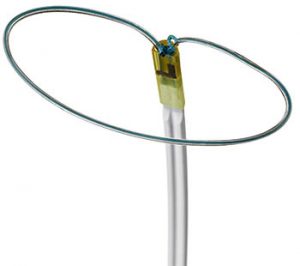LARIAT Suturing of The Left Atrial Appendage
 Patients with atrial fibrillation (AFib) experience a risk of stroke five times higher than those who do not have the condition. The most common cause of stroke occurs as a result of the pooling of blood and resultant clotting within the left atrium, often as a result of the irregular and fast heartbeat generated by AFib. The left atrial appendage, or LAA, is a part of the left atrium that may cease to function normally during AFib. As a result, blood pools in the LAA, creating an environment conducive to blood clotting and stroke.
Patients with atrial fibrillation (AFib) experience a risk of stroke five times higher than those who do not have the condition. The most common cause of stroke occurs as a result of the pooling of blood and resultant clotting within the left atrium, often as a result of the irregular and fast heartbeat generated by AFib. The left atrial appendage, or LAA, is a part of the left atrium that may cease to function normally during AFib. As a result, blood pools in the LAA, creating an environment conducive to blood clotting and stroke.
Blood thinners reduce the risk of stroke by stopping clotting in the LAA and elsewhere. Blood thinners are presently considered the gold standard for the prevention of strokes in patients with atrial fibrillation. They reduce the risk of stroke and systemic embolism by about 64-66%. However, for a wide variety of reasons not all patients can take blood thinners. Some patients have strokes despite blood thinners, while others experience bleeding that may be spontaneous and life threatening with or without trauma. The LARIAT device uses a minimally invasive approach to deliver a suture to permanently close the LAA. In addition, there is ongoing research into the possibility that the LAA may play an important role in causing Afib itself, such that closing it with a LARIAT may add additional success to an Afib ablation procedure.

How does the LARIAT procedure work?
The left atrium is accessed with a catheter in a fashion similar to other heart procedures such as an ablation. What makes the LARIAT procedure unique is that a needle is also used to place a a catheter under the ribs into the outer lining of the heart. This space is usually only accessible to surgeons via open chest procedures, but with the LARIAT technique it can be accessed with only the small needle and wire. Using the LARIAT Suture Delivery Device, the physician will then seal the LAA shut. By closing the LAA permanently, a blood clot can no longer form inside it– about 95% of all blood clots that cause strokes in AFib patients form in the LAA.
Risks & Considerations of LARIAT
- While suturing the LAA closed reduces the chance of blood pooling in the heart, the LAA is not the only possible location for the development of blood clots.
- There are inherent surgical risks.
- There is ongoing debate as to the usefulness of the LAA itself and how occluding it can affect the heart’s function. We must carefully balance the risks of the procedure with the perceived benefits.
aMAZE Clinical Trial
![]() The ongoing aMAZE trial is evaluating the effectiveness of a combination of two procedures to treat persistent atrial fibrillation. Learn more >>
The ongoing aMAZE trial is evaluating the effectiveness of a combination of two procedures to treat persistent atrial fibrillation. Learn more >>

